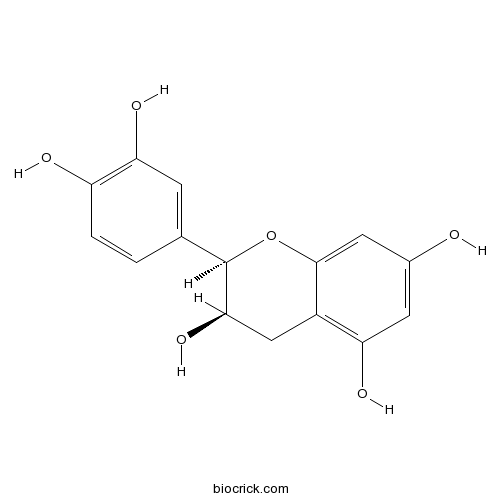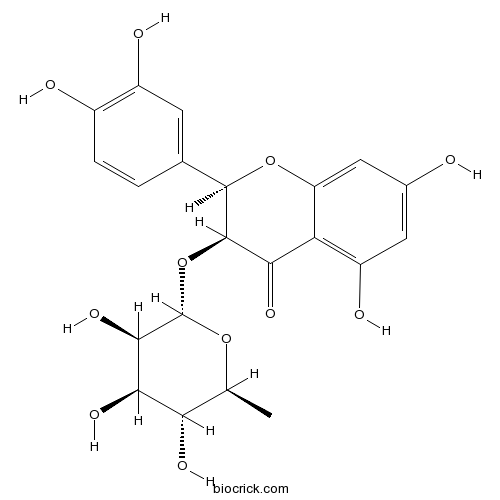Smilax glabra
Smilax glabra
1. The products in our compound library are selected from thousands of unique natural products; 2. It has the characteristics of diverse structure, diverse sources and wide coverage of activities; 3. Provide information on the activity of products from major journals, patents and research reports around the world, providing theoretical direction and research basis for further research and screening; 4. Free combination according to the type, source, target and disease of natural product; 5. The compound powder is placed in a covered tube and then discharged into a 10 x 10 cryostat; 6. Transport in ice pack or dry ice pack. Please store it at -20 °C as soon as possible after receiving the product, and use it as soon as possible after opening.
Natural products/compounds from Smilax glabra
- Cat.No. Product Name CAS Number COA
-
BCN5204
Astilbin29838-67-3
Instructions

-
BCN5597
Epicatechin490-46-0
Instructions

-
BCN8853
Neoastilbin54081-47-9
Instructions

-
BCN5719
Isoastilbin54081-48-0
Instructions

-
BCN6532
Neoisoastilbin54141-72-9
Instructions

-
BCN1025
Nicotinamide98-92-0
Instructions

Proapoptic and immunotoxic effects of sulfur-fumigated polysaccharides from Smilax glabra Roxb. in RAW264.7 cells.[Pubmed: 30012344]
The herbs with sulfur-fumigation may induce chemical transformation thus causing harmful effects on patients. In the current study, the difference of physicochemical property from sulfur-fumigated Smilax glabra Roxb. polysaccharides (SSGRP) and non-fumigated Smilax glabra Roxb. polysaccharides (NSGRP) were characterized and compared, such as external appearance, dissolvability, extraction yield, glucose content, inorganic elements analysis, UV and IR scanning spectrum. Additionally, the immunotoxicity and mechanisms of SSGRP and NSGRP on immune response of murine abdominal RAW264.7 macrophage cells were evaluated by cell viability, flow cytometry, quantitative real-time PCR and western blotting analyses. The results demonstrated that NSGRP could not affect the proliferation of RAW264.7 cells but SSGRP could effectively inhibit the cells viability by inducing apoptosis. SSGRP could also up-regulated the mRNA expression of apoptosis factors including Bax and caspase-8. Further investigation elucidated that NSGRP exhibited excellent immunomodulatory activity of RAW264.7 cells, however, SSGRP might inhibit the activity through down-regulating the tumor necrosis factor-α (TNF-α) and interleukin-6 (IL-6) mRNA expression as well as blocking the phosphorylation of phosphorylated extracellular signal-regulated kinase (ERK1/2) and c-Jun N-terminal kinase (JNK). In conclusion, our study suggested that sulfur-fumigation displayed significant immune toxicity on immune response of murine abdominal RAW264.7 macrophages, and the study provided new insights in controlling the sulfur-fumigation processing and storage method in Chinese herbal medicines.
Rapid discrimination of raw and sulfur-fumigated Smilax glabra based on chemical profiles by UHPLC-QTOF-MS/MS coupled with multivariate statistical analysis.[Pubmed: 29735052]
Smilax glabra (SG) is commonly used as a traditional edible herb in eastern Asia. Recently, sulfur-fumigation has been frequently used in order to obtain better color and a longer storage lifetime. However, the chemical alterations caused by this process remain unknown. The aim of this research was to explore potential chemical differences between non-fumigated and sulfur-fumigated SG samples. A novel approach was developed by using ultra-high-performance liquid chromatography-quadrupole/time-of-flight mass spectrometry (UHPLC-QTOF-MS/MS) with principal component analysis (PCA) and orthogonal partial squared discriminant analysis (OPLS-DA). Fifty-eight compounds were unambiguously characterized or tentatively identified in the chemical profiles for the first time. Six newly generated sulfur-containing compounds, namely glucosyringic acid sulfate, 5-O-caffeoylshikimic acid sulfite, 3-O-caffeoylshikimic acid sulfite, 5-O-caffeoylshikimic acid sulfate, 3-O-caffeoylshikimic acid sulfate and astilbin sulfate, were screened out to be the most characteristic markers for distinguishing non-fumigated and sulfur-fumigated SG. This newly proposed approach can not only be applied for exploring chemical markers but can also be used to investigate the chemical transformation mechanism associated with sulfur for other edible herbs.
Separation of Seven Polyphenols from the Rhizome of Smilax glabra by Offline Two Dimension Recycling HSCCC with Extrusion Mode.[Pubmed: 29495285]
None
Distinguishing Smilax glabra and Smilax china rhizomes by flow-injection mass spectrometry combined with principal component analysis.[Pubmed: 29453916]
Flow-injection mass spectrometry (FIMS) coupled with a chemometric method is proposed in this study to profile and distinguish between rhizomes of Smilax glabra (S. glabra) and Smilax china (S. china). The proposed method employed an electrospray-time-of-flight MS. The MS fingerprints were analyzed using principal component analysis (PCA) and orthogonal partial least squares discriminant analysis (OPLS-DA) with the aid of SIMCA software. Findings showed that the two kinds of samples perfectly fell into their own classes. Further predictive study showed desirable predictability and the tested samples were successfully and reliably identified. The study demonstrated that the proposed method could serve as a powerful tool for distinguishing between S. glabra and S. china.
Ethnomedicine, Phytochemistry and Pharmacology of Smilax glabra: An Important Traditional Chinese Medicine.[Pubmed: 29433390]
Smilax glabra (SG) Roxb., a well-known traditional Chinese medicine, has been extensively used worldwide for its marked pharmacological activities for treating syphilitic poisoned sores, limb hypertonicity, morbid leucorrhea, eczema pruritus, strangury due to heat, carbuncle toxin, and many other human ailments. Approximately 200 chemical compounds have been isolated from SG Roxb., and the major components have been determined to be flavonoids and flavonoid glycosides, phenolic acids, and steroids. Among these active compounds, the effects of astilbin, which is used as a quality control marker to determine the quality of SG Roxb., have been widely investigated. Based on in vivo and in vitro studies, the primary active components of SG Roxb. possess various pharmacological activities, such as cytotoxic, anti-inflammatory and immune-modulatory effects, anti-oxidant, hepatoprotective, antiviral, antibacterial, and cardiovascular system protective activities. However, an extensive study to determine the relationship between the chemical compositions and pharmacological effects of SG Roxb. has not been conducted and is worth of our study. Improving the means of utilizing the effects of SG is crucial. The present paper reviews the ethnopharmacology, phytochemistry, and pharmacology of SG Roxb. and assesses its ethnopharmacological use in order to explore its therapeutic potential for future research.
Three new flavonoid glycosides from Smilax glabra and their anti-inflammatory activity.[Pubmed: 29149807]
Three new flavonoid glycosides, 2(S)-5-hydroxy-6,8-dimethoxyflavonone-7-O-β-D-glucopyranosyl-(1→6)-O-β-D-glucopyranoside (1), 5-hydroxy-3,8-dimethoxyflavone-7-O-β-D-glucopyranosyl-(1→6)-O-β-D-glucopyranoside (2) and 3,7-dihydroxy-8-methoxyflavone-6-O-β-D-glucopyranosyl-(1→6)-O-β-D-glucopyranoside (3), together with five known flavonoids (4-8) were isolated from the roots of Smilax glabra Roxb. Their structures were elucidated on the basis of chemical and spectral evidence, as well as by comparison with literature data. Three new flavonoids were subjected to evaluate anti-inflammatory activity. Compounds 1-3 inhibited the NF κB induction by 32.2, 55.8 and 61.7%, respectively.
Astilbin decreases proliferation and improves differentiation in HaCaT keratinocytes.[Pubmed: 28700975]
Psoriasis is a common chronic dermatosis characterized by keratinocyte hyperproliferation accompanied by inflammatory reactions. Pathological changes upset the balance between keratinocyte proliferation, differentiation, and death in psoriatic lesions, suggesting that molecules with topical anti-inflammatory, anti-proliferation and anti-angiogenesis abilities may be useful for its treatment. The flavonoid astilbin is the major active component extracted from the rhizome of Smilax glabra, which has been widely used in China to treat inflammatory and autoimmune diseases. Here, we investigate the potential of astilbin as a treatment for psoriasis. We reveal that astilbin inhibits the growth of HaCaT keratinocytes. Detailed study shows that astilbin leads to S phase arrest of the cell cycle by induction of p53 and p21 and activated-AMPK. Additionally, astilbin induced keratinocyte differentiation correlated with suppression of keratin 5 (KRT5) and KRT14 proteins (the markers of epidermal basal layer) and induction KRT1 and KRT10 proteins (occurring in the upper layers). Moreover, astilbin regulates the expression of VEGF in human HaCaT keratinocytes. These results suggest that astilbin may be a promising agent for psoriasis treatment.


